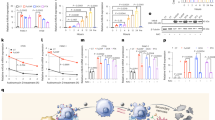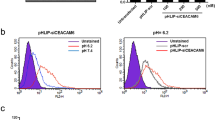Abstract
Clinical application of small interfering RNA (siRNA) in cancer therapy has been limited by the lack of an efficient systemic siRNA delivery system. In this report we describe an efficient siRNA delivery system directed to metastasized tumors, especially in the lungs. Anticancer siRNA was condensed in the presence of 9-arginine peptides (9Arg) and then complexed with cationic O,O'-dimyristyl-N-lysyl glutamate liposomes conjugated to antibodies against the epidermal growth factor receptor (EGFR). The ternary complex of optimized anti-EGFR-9Arg-lipoplexes exhibited efficient siRNA transfection of LS174T-Luc cancer cells grown in culture or orthotopically in mouse lungs. Anti-tumor Bcl-2/survivin siRNAs loaded in the anti-EGFR-9Arg-lipoplexes effectively suppressed transcription of their target genes, resulting in an efficient cancer cell death. Repeated intravenous administrations of the anti-EGFR-9Arg-lipoplexes effectively inhibited tumor growth in the mouse lungs and prolonged survival of the mice compared with nontargeted lipoplexes. These results suggest that the ternary complexes of anti-EGFR-9Arg-lipoplexes might have clinical applications in RNA interference cancer therapy.
This is a preview of subscription content, access via your institution
Access options
Subscribe to this journal
Receive 12 print issues and online access
$259.00 per year
only $21.58 per issue
Buy this article
- Purchase on Springer Link
- Instant access to full article PDF
Prices may be subject to local taxes which are calculated during checkout







Similar content being viewed by others
References
Shuey DJ, McCallus DE, Giordano T . RNAi: gene-silencing in therapeutic intervention. Drug Discov Today 2002; 20: 1040–1046.
Uprichard SL . The therapeutic potential of RNA interference. FEBS Lett 2005; 579: 5996–6007.
Ozpolat B, Sood AK, Lopez-Berestein G . Nanomedicine based approaches for the delivery of siRNA in cancer. J Intern Med 2010; 267: 44–53.
Vicentini FT, Borgheti-Cardoso LN, Depieri LV, de Macedo Mano D, Abelha TF, Petrilli R et al. Delivery systems and local administration routes for therapeutic siRNA. Pharm Res 2013; 30: 915–931.
Akhtar S, Benter IF . Nonviral delivery of synthetic siRNAs in vivo. J Clin Invest 2007; 117: 3623–3632.
Xie FY, Woodle MC, Lu PY . Harnessing in vivo siRNA delivery for drug discovery and therapeutic development. Drug Discov Today 2006; 11: 67–73.
Felgner PL, Ringold GM . Cationic liposome-mediated transfection. Nature 1989; 337: 387–388.
Sioud M, Sørensen DR . Cationic liposome-mediated delivery of siRNAs in adult mice. Biochem Biophys Res Commun 2003; 312: 1220–1225.
Ragelle H, Vandermeulen G, Préat V . Chitosan-based siRNA delivery systems. J Control Release 2013; 172: 207–218.
Zhang S, Zhao B, Jiang H, Wang B, Ma B . Cationic lipids and polymers mediated vectors for delivery of siRNA. J Control Release 2007; 123: 1–10.
Brannon-Peppas L, Blanchette JO . Nanoparticle and targeted systems for cancer therapy. Adv Drug Deliv Rev 2012; 64: 206–212.
Gao J, Liu W, Xia Y, Li W, Sun J, Chen H et al. The promotion of siRNA delivery to breast cancer overexpressing epidermal growth factor receptor through anti-EGFR antibody conjugation by immunoliposomes. Biomaterials 2011; 32: 3459–3470.
Gao J, Sun J, Li H, Liu W, Zhang Y, Li B et al. Lyophilized HER2-specific PEGylated immunoliposomes for active siRNA gene silencing. Biomaterials 2010; 31: 2655–2664.
Jiang J, Yang SJ, Wang JC, Yang LJ, Xu ZZ, Yang T et al. Sequential treatment of drug-resistant tumors with RGD-modified liposomes containing siRNA or doxorubicin. Eur J Pharm Biopharm 2010; 76: 170–178.
Danhier F, Vroman B, Lecouturier N, Crokart N, Pourcelle V, Freichels H et al. Targeting of tumor endothelium by RGD-grafted PLGA-nanoparticles loaded with Paclitaxel. J Control Release 2009; 140: 166–173.
Farokhzad OC, Jon S, Khademhosseini A, Tran TNT, LaVan DA, Langer R et al. Nanoparticle-Aptamer Bioconjugates: A New Approach for Targeting Prostate Cancer Cells. Cancer Res 2004; 64: 7668–7672.
Pirollo KF, Chang EH . Targeted delivery of small interfering RNA: approaching effective cancer therapies. Cancer Res 2008; 68: 1247–1250.
Yang Y, Li J, Liu F, Huang L . Systemic delivery of siRNA via LCP nanoparticle efficiently inhibits lung metastasis. Mol Ther 2012; 20: 609–615.
Zaffaroni N, Pennati M, Daidone MG . Survivin as a target for new anticancer interventions. J Cell Mol Med 2005; 9: 360–372.
Wacheck V, Losert D, Günsberg P, Vornlocher HP, Hadwiger P, Geick A et al. Small Interfering RNA Targeting Bcl-2 Sensitizes Malignant Melanoma. Oligonucleotides 2003; 13: 393–400.
Kim HS, Song IH, Kim JC, Kim EJ, Jang DO, Park YS . In vitro and in vivo gene-transferring characteristics of novel cationic lipids, DMKD (O,O'-dimyristyl-N-lysyl aspartate) and DMKE (O,O'-dimyristyl-N-lysyl glutamate). J Control Release 2006; 115: 234–241.
Sadahiro S, Suzuki T, Ishikawa K, Nakamura T, Tanaka Y, Masuda T et al. Recurrence patterns after curative resection of colorectal cancer in patients followed for a minimum of ten years. Hepatogastroenterology 2003; 50: 1362–1366.
Scheithauer W, Rosen H, Kornek GV, Sebesta C, Depisch D . Randomised comparison of combination chemotherapy plus supportive care with supportive care alone in patients with metastatic colorectal cancer. BMJ 1993; 306: 752–755.
Guo J, Evans JC, O’Driscoll CM . Delivering RNAi therapeutics with non-viral technology: a promising strategy for prostate cancer? Trends Mol Med 2013; 19: 250–261.
Gao X, Huang L . Potentiation of cationic liposome-mediated gene delivery by polycations. Biochemistry 1996; 35: 1027–1036.
Zhang C, Tang N, Liu XJ, Liang W, Xu W, Torchilin VP . siRNA-containing liposomes modified with polyarginine effectively silence the targeted gene. J Control Release 2006; 112: 229–239.
Won YW, Yoon SM, Lee KM, Kim YH . Poly(oligo-D-arginine) with internal disulfide linkages as a cytoplasm-sensitive carrier for siRNA delivery. Mol Ther 2011; 19: 372–380.
Tagalakis AD, Saraiva L, McCarthy D, Gustafsson KT, Hart SL . Comparison of nanocomplexes with branched and linear peptides for siRNA delivery. Biomacromolecules 2013; 14: 761–770.
Park JW, Hong K, Kirpotin DB, Colbern G, Shalaby R, Baselga J et al. Anti-HER2 Immunoliposomes: Enhanced Efficacy Attributable toTargeted Delivery. Clin Cancer Res 2002; 8: 1172–1181.
Addepalli MK, Ray KB, Kumar B, Ramnath RL, Chile S, Rao H . RNAi-mediated knockdown of AURKB and EGFR shows enhanced therapeutic efficacy in prostate tumor regression. Gene Ther 2010; 17: 352–359.
Gill C, Dowling C, O'Neill AJ, Watson RW . Effects of cIAP-1, cIAP-2 and XIAP triple knockdown on prostate cancer cell susceptibility to apoptosis, cell survival and proliferation. Mol Cancer 2009; 8: 39.
Tsujimoto Y, Finger LR, Yunis J, Nowell PC, Croce CM . Cloning of the chromosome breakpoint of neoplastic B cells with the t(14;18) chromosome translocation. Science 1984; 226: 1097–1099.
Reed JC . Dysregulation of apoptosis in cancer. J Clin Oncol 1999; 17: 2941–2953.
Tamm I, Wang Y, Sausville E, Scudiero DA, Vigna N, Oltersdorf T et al. IAP-family protein survivin inhibits caspase activity and apoptosis induced by Fas (CD95), Bax, caspases, and anticancer drugs. Cancer Res 1998; 58: 5315–5320.
Acknowledgements
This research was funded by the National Cancer Center (0920200), the National Research Fund of Korea (2009-0077433) and Nuclear Research & Development Program (No. 50526-2014) of the Ministry of Science, ICT and Future Planning.
Author information
Authors and Affiliations
Corresponding author
Ethics declarations
Competing interests
The authors declare no conflict of interest.
Rights and permissions
About this article
Cite this article
Lee, Y., Lee, T., Song, I. et al. Inhibition of pulmonary cancer progression by epidermal growth factor receptor-targeted transfection with Bcl-2 and survivin siRNAs. Cancer Gene Ther 22, 335–343 (2015). https://doi.org/10.1038/cgt.2015.18
Received:
Revised:
Accepted:
Published:
Issue Date:
DOI: https://doi.org/10.1038/cgt.2015.18
This article is cited by
-
Cancer therapeutics using survivin BIRC5 as a target: what can we do after over two decades of study?
Journal of Experimental & Clinical Cancer Research (2019)
-
Cancer-targeted Nucleic Acid Delivery and Quantum Dot Imaging Using EGF Receptor Aptamer-conjugated Lipid Nanoparticles
Scientific Reports (2017)



